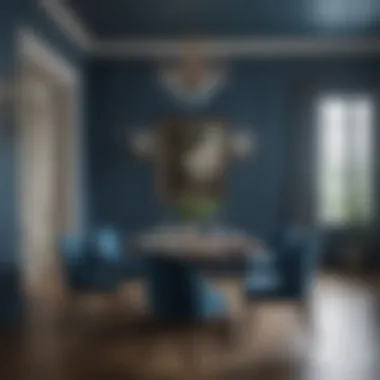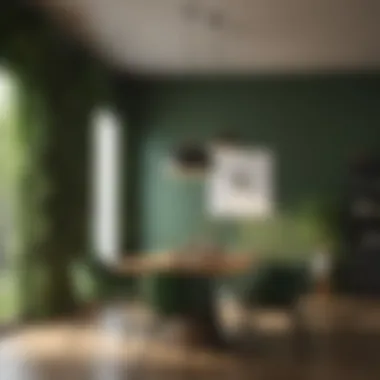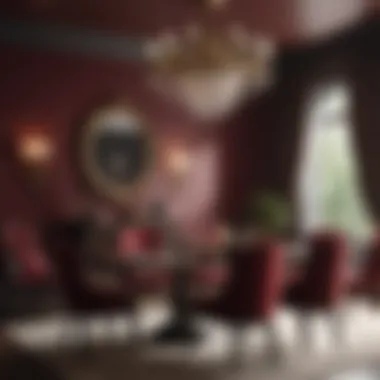Best Wall Colors for Your Dining Room


Intro
Selecting the appropriate wall color for your dining room is more than just a design choice. It affects how space feels and can even alter the dining experience. Tasteful color selections can create warmth, provoke appetite or promote relaxation, hence making it an integral aspect of interior design. In this guide, we explore best practices in choosing wall colors that cater to aesthetic demands while ensuring functional aspects are not overlooked.
Understanding color psychology is essential. Different colors evoke different feelings and moods. For instance, warm colors like red and orange tend to energize and stimulate conversation, making them ideal for lively dinners. On the other hand, cooler colors like blue and green may encourage calmness and tranquility, suited for more intimate gatherings. Let's delve deeper into the latest trends and practical advice to transform your dining area into a captivating space.
Key Insights and Trends
Current trends in interior design
In recent years, minimalistic designs have risen in popularity, with an emphasis on neutral palettes. Shades of white, beige, and gray create a serene backdrop that is versatile. However, rich jewel tones are also gaining traction. Deep blues and emerald greens can provide a striking contrast to lighter furnishings, embodying elegance and sophistication.
Aside from color, patterns and textures play a vital role too. Consider wall treatments such as wainscoting or textured wallpapers to add depth without overwhelming the space. These elements can accentuate color choices while maintaining a sense of modernity.
"Colors are the smiles of nature." – Leigh Hunt
Popular dining room colors of the season
Several colors have emerged as favorites among homeowners and designers this season. Here are some notable mentions:
- Soft Sage Green: A tranquil hue that brings the outdoors in.
- Muted Terracotta: Earthy tones that stimulate warmth and comfort.
- Dusty Blue: A calming and sophisticated choice that pairs well with white or beige.
- Bold Charcoal: Perfect for a modern look, charcoal walls can create a dramatic impact.
These colors not only highlight contemporary trends but also blend seamlessly with various decor styles.
Practical Tips and How-To Guides
Step-by-step guides for home decoration projects
- Assess your space: Start by evaluating the size and natural light in the dining room. Dark colors can make a small room feel smaller, so keep that in mind.
- Consider existing decor: Align your color choice with furniture, artwork, and other decorative elements. This ensures cohesiveness.
- Test samples: Before committing, sample a few colors on your walls. Observe how they look in different lighting throughout the day.
- Finalize your choice: Once you're satisfied with the samples, purchase paint and gather necessary supplies. Remeber to prep surfaces before painting.
Entertaining tips and planning checklists
- Create an inviting atmosphere: Use warm lighting to complement your wall color. Consider using dimmers for flexibility.
- Choose an appropriate table setting: Colors of tableware should harmonize with your wall color to create a seamless environment during dining.
- Personal touches: Incorporate elements like centerpieces or wall art that reflect your style, augmenting the overall aesthetic.
A well-considered wall color can elevate not just the atmosphere of your dining room but also the overall dining experience. Whether you're planning intimate gatherings or lively dinners, understanding the psychological impact of colors and keeping up with trends will help you curate a space that feels inviting and stylish.
Intro to Dining Room Colors
Choosing the right wall color for a dining room is not just a matter of aesthetics but plays a crucial role in how the space feels and functions. The dining room is often a place where family and friends gather, sharing meals and creating lasting memories. Therefore, the colors that adorn its walls can significantly influence the atmosphere and overall experience.
Understanding the significance of color selection begins with recognizing that certain hues evoke specific emotions. This can impact everything from the energy in the room to how inviting it feels. It is essential to consider how different colors will affect conversations and dining experiences. For example, warmer colors may promote social interaction, while cooler tones can evoke a sense of calm.
Additionally, it's important to think about the lighting conditions in the room. Natural light, artificial light, and the orientation of the space can all alter how colors appear. A color that looks vibrant in daylight might seem dull in the evening, thus affecting the ambiance during dinner parties or family gatherings.
As we delve deeper into this topic, we will explore various color options, from neutral palettes that create a timeless elegant look to bold colors that express personality. Throughout this article, we aim to guide homeowners and interior design enthusiasts in selecting the most suitable wall colors that enhance their dining spaces while considering practical aspects of color application.
"The right color can transform a dining room into an inviting space that encourages connection and conversation."
Understanding interior design color theory will equip readers with the knowledge to choose colors that not only suit their tastes but also harmonize with existing decor. This thoughtful approach ensures that each choice complements the overall dining experience.
Popular Color Schemes for Dining Rooms
Choosing the right color scheme for a dining room is essential. Color schemes not only influence the aesthetic appeal but also affect the mood and atmosphere. A well-selected palette can create a space that is inviting and comfortable for family gatherings and dinner parties. Understanding popular color schemes helps homeowners and interior design enthusiasts navigate their options, leading to informed decisions regarding paint choices.
Neutral Palettes
Neutral colors offer versatility and a calming backdrop for a dining room.


Whites and off-whites
Whites and off-whites are classic choices for dining rooms. One of their key characteristics is the ability to reflect light, making a space feel brighter and larger. This is particularly beneficial in smaller dining areas. These tones are perfect for creating a clean, modern look. A unique feature of whites is their compatibility with almost any decor style, be it traditional or contemporary. However, the downside may include their tendency to show dirt and scuffs more easily, requiring more maintenance.
Beiges and taupes
Beiges and taupes create warmth without overwhelming the space. The neutral tones of these colors promote a cozy atmosphere that makes dining experiences more enjoyable. One striking feature is their warmth, which can soften stark environments. They pair well with wooden furniture and vintage decor, adding depth to the design. On the downside, beiges and taupes can sometimes appear dull or monotonous, especially if combined with other equally muted tones.
Grays and grays with undertones
Grays offer a modern edge that many homeowners appreciate. They serve as a perfect backdrop that enhances other colors. The unique aspect of grays, especially those with undertones, is their adaptability; they can shift in appearance depending on the lighting. This provides a dynamic quality, keeping the room visually interesting. However, the wrong shade of gray can sometimes lend a cold or uninviting feeling, so careful selection is vital.
Warm Colors
Warm colors are energetic and stimulating. They can enhance social interactions and encourage conversation, making them ideal for dining areas.
Reds and burgundies
Reds and burgundies evoke warmth and passion. Their vibrant tones can create a lively atmosphere, essential for social gatherings. One notable feature of these colors is their ability to stimulate appetite and conversation. On the potential downside, too much red may be overwhelming. It’s crucial to balance its intensity with neutral elements to avoid creating an agitated space.
Oranges and terracotta
Oranges and terracotta bring a rustic charm to dining rooms. Their rich, earthy tones provide warmth that invites relaxation. These colors are particularly suitable for eclectic or Mediterranean styles. Notably, terracotta can introduce texture and organic appeal. However, they may not suit every style or preference, potentially limiting choice for some homeowners.
Yellows and golds
Yellows and golds are cheerful and bright, enhancing the lightness of a room. These colors encourage a sense of happiness and positivity. Particularly, light yellows can evoke a feeling of sunshine. However, excessive yellow can be jarring, leading to a less serene environment. Finding the right balance is essential to utilizing these shades effectively.
Cool Colors
Cool colors create a calm and serene environment, making them ideal for relaxing dining experiences.
Blues and teal
Blues and teal invite tranquility. They can reduce stress, making meals more enjoyable. Their refreshing tones are often associated with nature, promoting a serene atmosphere. A unique aspect of teal is its dual nature; it can be both vibrant and soothing, depending on the shade. However, if used excessively, these colors can make a space feel too cool or detached, which detracts from warmth in dining settings.
Greens and sage
Greens and sage offer a refreshing feel reminiscent of nature. Their calming influence can create a restorative ambience, conducive to relaxed dining experiences. The unique feature of sage is its soft demeanor that fits well with casual decor. While greens are versatile, they can sometimes clash with other colors if not balanced properly, requiring careful curation.
Purples and lavenders
Purples and lavenders add a touch of sophistication. Their royal tones can impart a sense of luxury without being overly imposing. They work wonderfully in dining rooms seeking a more refined aesthetic. The key consideration here is that they have the potential to evoke various emotions depending on the shade used. However, choosing the wrong hue might lead to an overly dramatic or heavy space, which may not align with the intended dining experience.
Color Psychology in Dining Spaces
Understanding color psychology is essential when choosing wall colors for dining rooms. The colors you select are not merely aesthetic choices; they also impact the overall mood and experience of the space. Dining rooms often serve as gathering spots for family and friends to share meals, celebrate occasions, and engage in conversation. Hence, selecting the right hues can enhance social interaction and foster a warm atmosphere.
The psychological effects of colors are profound. For instance, certain shades can induce energy, while others promote calm and relaxation. Homeowners should consider how they want their dining area to feel. Elements like the size of the room, the natural light available, and the existing decor should align with the chosen colors. By understanding these psychological nuances, individuals can create a dining environment that meets their goals.
Choosing Colors Based on Desired Mood
Colors for energy and conversation
Colors that stimulate energy and conversation are vital, especially in a dining space. Bright and bold hues, such as reds and oranges, can increase alertness and fiery interactions among guests. These colors are often seen as trendy and lively, making them popular choices for spaces where socialization is the goal. A red wall can potentially enhance one’s appetite; at the same time, it can create a vibrant backdrop for lively conversations.
The unique feature of these energetic colors lies in their ability to create a dynamic atmosphere. However, homeowners must consider them carefully, as too much vibrancy might become overwhelming. Ambients that balance energizing tones with neutral shades can be effective, allowing a lively spirit without causing unease.


Colors for calm and relaxation
On the other hand, calm colors serve a different purpose in dining rooms. Soft blues, greens, and neutrals can create a tranquil dining environment conducive to relaxation and extended meals. These shades help to reduce stress and create a welcoming atmosphere that encourages lingering over dinner. A pale blue wall, for example, can make the space feel airy and serene.
The characteristic of calming colors is their understated quality, which allows for conversation without distraction. They are an excellent option for those aiming for a peaceful dining experience. However, it is crucial to harmonize these hues with the overall decor. To maintain visual interest, consider textures or accents that complement the soft colors.
The Effect of Light on Color Perception
Light plays a pivotal role in how colors are perceived. Natural light tends to enhance the vibrancy of colors, which can soften or intensify certain shades. For example, a cream wall can appear warmer in sunlight but might seem cooler under artificial lights. Understanding these variations is crucial in selecting the best paint for dining rooms.
The type of lighting fixtures can also change color perception within the space. Warm white bulbs can create a cozy feeling, while cooler white lights can make colors appear sharper and more vivid. Homeowners should assess their dining area under different lighting conditions to ensure that their chosen colors meet their expectations.
Choosing wall colors requires not just a focus on preference, but an understanding of how colors transform meaning and connection within dining experiences.
Trends in Dining Room Wall Colors
Colors significantly influence the atmosphere of any room, especially in spaces where meals and social gatherings occur. This section evaluates current trends as well as timeless choices for dining room wall colors. Understanding these trends can aid homeowners and decorators in selecting hues that meet both aesthetic and practical considerations. Knowing the latest developments ensures that the dining area remains inviting and aligns with contemporary design philosophies.
Current Trends in Interior Design
Bold accent walls
Bold accent walls serve to create focal points within a dining space. This trend allows for experimentation with powerful colors or intricate patterns. Such choices can energize a room, making it visually engaging. For instance, a deep navy or a vibrant emerald green can command attention while contrasting elegantly with lighter shades.
One of the key advantages of bold accent walls is their versatility. They can adapt to various styles, whether sleek modern or rustic. However, balance is essential, as an overpowering color might overwhelm the aesthetics if not curated carefully. In this article, bold accent walls are endorsed as an effective method to break visual monotony while ensuring a memorable dining experience.
Layering of colors and textures
Layering colors and textures is an emerging trend that enhances depth and interest in a dining room. This approach often combines contrasting shades, such as rich chocolate brown against a muted beige, or fabrics with different textures, giving the room a sophisticated layered look.
The attractiveness of layering lies in its ability to convey a personalized and curated appearance. It allows for creativity while accommodating various tastes and design preferences. However, balanced execution is crucial. Excessive layering may create chaos rather than cohesiveness. Thus, it is a beneficial choice for those who wish to maintain harmony while still showcasing individuality.
Timeless Choices
Timeless choices continue to hold relevance despite changing trends. They provide reliable alternatives that ensure lasting appeal and adaptability.
Classic white and cream
Classic white and cream remain among the most favored choices for dining rooms. These colors provide a clean backdrop that enhances the surrounding furnishings and decor. White reflects light effectively, contributing to a spacious feel. Cream offers warmth, creating a more inviting ambiance.
The benefit of choosing classic white or cream is their compatibility with various design elements. Whether modern, traditional, or eclectic, these colors harmonize effortlessly. They present a neutral canvas that allows for flexibility in decorative selection. The downside may include their susceptibility to showing dirt or wear. Nonetheless, frequent maintenance can easily address this.
Soft pastels
Soft pastels have gained popularity due to their calming and serene qualities. Colors like mint green, soft pink, or powder blue invite relaxation and companionship. Soft pastels tend to create a tranquil atmosphere, making them ideal for intimate dining experiences.
This color choice is advantageous for those looking to create a more casual or friendly environment. Additionally, soft pastels can enhance natural light, making spaces feel bright and airy. However, they might not appeal to those preferring bolder or more dramatic settings. Careful consideration should be applied to ensure that soft pastels align with the overall design intent.
In summary, the selection of wall colors in dining rooms can dramatically impact the ambiance of the space. By understanding and implementing both current trends and timeless choices, one can achieve a refined yet inviting setting.
Practical Considerations for Choosing Colors
Choosing the right color for a dining room is not solely about aesthetics; it also involves careful consideration of several practical aspects. Understanding these elements can significantly influence the overall appeal and functionality of the space. Thus, exploring room size and layout, along with how to harmonize color choices with existing decor, become crucial strategies.
Assessing Room Size and Layout
Room size has a direct correlation with the chosen color. In smaller dining areas, lighter colors create a sense of openness. These hues reflect light, making the space appear larger and airier. Conversely, darker shades can close in a room, lending a cozy feel, but they may also make the area feel cramped if overused.


The layout also matters. A long, narrow dining room may benefit from balancing colors. Using contrasting shades for different zones can help define spaces, making the room more functional while still stylish. For instance, choosing a gradient of colors from light at one end to deeper shades at the other can visually stretch the space.
Harmonizing with Existing Decor
Color harmony enhances the overall dining experience. It is crucial to make color choices that blend well with the existing elements within the dining room.
Flooring considerations
The type of flooring can dictate color choices on the walls. Dark hardwood can clash with equally dark wall colors, producing a heavy appearance. Lighter floorings, such as beige tiles, may work well with both warm and cool wall colors, allowing greater flexibility in design. Choosing paint that complements flooring can elevate the ambiance.
Natural stone floors are often neutral, providing great adaptability in color selection. For example, a muted green can beautifully resonate with grey or brown tones in the stone without overwhelming the palate. The essential benefit in flooring consideration is the ability to amplify visual cohesion with wall colors while preserving an inviting and balanced look.
Furniture and fixture compatibility
Furniture and light fixtures play a pivotal role in choosing wall colors. The materials, colors, and even the vintage of furniture can inform the palette. A modern dining table paired with vibrant wall colors can create an inviting atmosphere, whereas an antique table might lean more toward muted tones.
The unique feature of compatibility is that it caters to the personal style while also directing the mood of the dining space. For example, if your furniture is a rich, dark wood, cool colors on the walls may create a striking modern contrast, enhancing both items' character. This balance between fixtures and color serves to make the room visually harmonious while remaining distinctly personal.
Always consider how different elements in the room will interact with each other.
In summary, practical considerations not only elevate the design but ensure the dining room remains a functional space that maintains its purpose as a gathering area. By assessing room size, layout, and harmonizing with existing decor, you set the stage for an aesthetically pleasing and inviting dining environment.
Finishing Touches
Finishing touches in the dining room play a critical role in creating a cohesive and inviting atmosphere. This section emphasizes the subtle yet impactful elements that come together to finalize the overall aesthetic of the space. By carefully considering art, accessories, and lighting, one can enhance the chosen wall colors, elevating the dining experience.
Art and Accessories
Art and accessories lend personality and character to a dining room. Wall art, like paintings or prints, can echo the colors of the wall or introduce complementary hues. Accessories such as decorative plates or sculptures also serve to reinforce the theme of the room. When selecting art, consider its size and placement. Large pieces can create a focal point, while smaller items can be grouped for variety.
Adding textiles, such as table runners or throw pillows, can blend comfort with style. They can pull together the color scheme and add texture, making the room appear more dynamic. It is vital to select artworks and accessories that resonate with personal taste and unify the dining environment.
Lighting Considerations
Natural versus artificial lighting
Natural lighting has an undeniable influence on how wall colors appear throughout the day. Natural light can create a warm ambiance that enhances vibrant colors or softens darker shades. This type of lighting also tends to bring out the nuances in color, making a room feel lively and welcoming.
On the other hand, artificial lighting offers more control over the atmosphere. Choices in light fixtures can create specific moods, whether cozy or energetic. For example, warm light bulbs can provide a sense of intimacy, further elevating dinner gatherings.
In summary, both natural and artificial lighting work hand-in-hand to determine the richness of colors. Choosing the right balance between the two can dramatically impact the dining experience.
Adjusting color perception with light fixtures
Adjusting color perception with light fixtures can transform a dining room dramatically. Different types of bulbs produce varying color temperatures that affect how people perceive wall colors. By using warmer light bulbs, the room can feel more inviting and softer, which can complement warm wall colors. Alternatively, cooler light can intensify shadows and make colors appear sharper, great for highlighting art.
Light fixtures themselves can also serve as artistic elements. Unique designs can be statements contributing to the overall decor. When selecting fixtures, consider how their illumination affects the wall colors and overall color scheme of the room.
By thoughtfully combining artwork, accessories, and proper lighting choices, the finishing touches to a dining room can elevate its function and appearance, enhancing the dining experience for homeowners and guests alike.
The End
When selecting wall colors for your dining room, it is essential to consider the role color plays in creating a welcoming environment. This article has provided you with a comprehensive understanding of diverse color options and their effects on mood and setting, which is crucial for enhancing your dining experience.
Making an Informed Choice
Choosing the right color is not merely about preferences but also involves understanding how colors interact within the space. Start by assessing the size and layout of your room. Light colors tend to make a small room feel larger, while darker tones can create intimacy in a larger space.
In addition, harmonizing colors with existing decor is a key factor. Consider your flooring and the colors in your furniture. For example, if you have wooden furniture in dark shades, a warm neutral like taupe can be a harmonious backdrop. On the contrary, lighter furniture may stand out better against deeper hues like navy or forest green.
Also, it's beneficial to think about the psychological impact of colors. If you desire an energetic dining atmosphere, vibrant colors like reds and oranges might be appropriate. Alternatively, for a calm, serene environment, softer shades such as pastels or muted earthy tones will create a relaxing space for meals.
To truly make an informed choice, sample your selected colors in the room's lighting. Observe how the color shifts throughout the day. Natural light can enhance certain hues while artificial lighting might alter perception. Taking such steps is critical to ensuring that your final choice aligns with your aims for the space.



